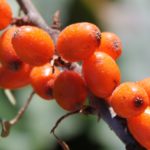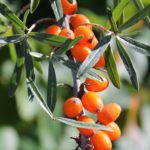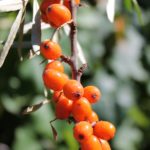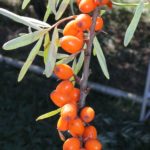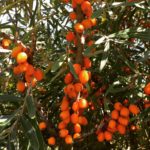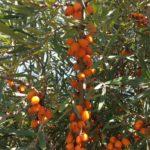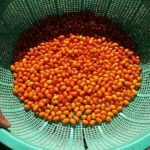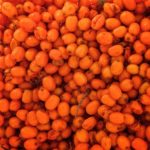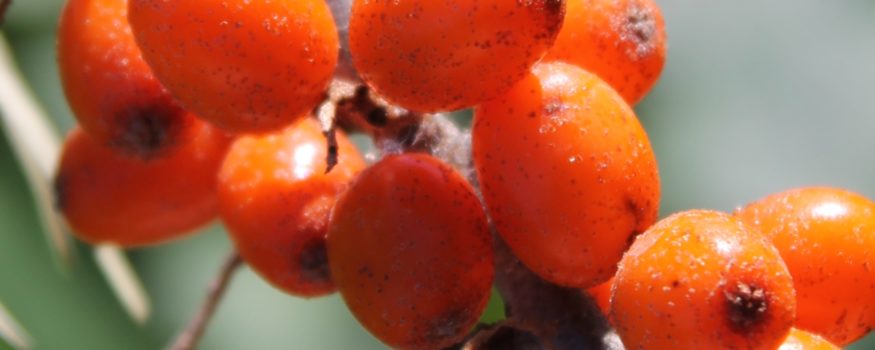
Sea Berry Growing Guide
Click link > Sea Berry Catalog
It is no secret that we are huge fans of the Sea Berry here at One Green World. The deliciously tangy and nutrient dense juice is what gives our crew the energy we need to get through the busy season as well as the flu season. Its uses are many and its presence in the North American landscape is relatively small, so we decided it was finally time to shine a bit of beta-Carotene drenched light on what is so special and perhaps even magical about this plant and its fruit. Follow along in this Sea Berry Growing Guide to learn a bit of history and gain a better understanding of this wonderful plant.
The Sea Berry, also known as Sea Buckthorn, is native to Europe and Asia where it grows along riverbanks, seashores, sandy dunes and mountain slopes from sea level all the way up to 12,000 feet. All parts of the plant have a long history of use in China and Russia where it has been wild harvested for centuries and more recently brought into commercial production. It has even made its way into a few myths and legends due to its many nutritious and medicinal qualities. The Latin name for its genus, Hippophae, translates to shiny horse in reference to its use in horse fodder. The leaves have such a high oil content that they were often mixed into horse food to produce a shiny coat on the animals. To this day they are still used in horse feeds and supplements. Some legends speak of farmers letting their old, decrepit horses out to roam the hills, thinking this far more humane than killing them. After a few days grazing on the wild Sea Berry plants that grew naturally on the hillsides, the horses would return to their owners and be mistaken for young, healthy colts with their newly shiny coats and returned vigor. It is also said that the mythic horse Pegasus feasted upon Sea Berries and it was these magical berries that gave him wings to fly. That’s about 4,000 years before energy drink companies were claiming the power of flight through their products, making Sea Berries the original energy drink! Obviously, we believe that Sea Berry juice is far superior to any other “energy” drink on the market today.
Cultivation of the Sea Berry has only come along relatively recently, beginning in Russia in the 1940’s. Scientists first began to research and discover what had long been known as folk medicine traditions. Some of the first commercially harvested Sea Berries in Russia were used in The Great Space Race, as they are believed to be very helpful in protecting humans from radiation. In preparation to leave Earth’s atmosphere, Yuri Gagarin was given an extraordinarily large dose of Sea Berries as well as a Sea Berry skin cream to protect against any potential radiation, thus making the Sea Berry the first cosmic berry!
Sea Berries were almost completely unknown to North American growers until it was introduced to Canada in the 1930’s by Dr. L. Skinner at the Morden Research Station in Manitoba. They were later planted out on the Canadian prairies by the Shelterbelt Center of the Prairie Farm Rehabilitation Administration. These hedgerows provided much of the genetic material to early North American Sea Berry researchers. The Canadians continue to plant out large shelterbelts of Sea Berries for stabilizing erodible soils, but the major developments in named fruiting cultivars have come to us from Europe and Asia, specifically in Russia.
And this is where our very own hometown hero Jim Gilbert, the founder of One Green World, enters the Sea Berry scene. Jim, who is fluent in Russian, has taken many trips to Europe and Russia over the years to collect Sea Berry varieties from plant breeders who have selected the finest fruiting cultivars known to the world, and brought them back here to make them available to North American growers. Many farmers around the country have since grown out seedlings of these varieties in attempts to improve upon them but breeding programs in North America are still very much in their infancy.
Growing Sea Berry plants
As of now there are very few large-scale Sea Berry productions in North America so Sea Berry products, aside from in the pharmaceutical and cosmetics industry, are nearly impossible to find. Like so many of the finest fruits, if you want Sea Berries you’ll have to grow your own plants. Thankfully it is one of the easiest plants to grow, is incredibly vigorous, and is pest and disease free!
Site Selection for Sea Berry plants
When selecting your planting site the first thing to consider is that Sea Berries are very shade intolerant. As a pioneer species that is adapted to colonizing disturbed areas it requires full day sunlight to reach maximum productivity. It is possible to grow Sea Berries in half day sun, but anything below six hours of direct sunlight and productivity begins to decline drastically.
Good drainage is essential as well, otherwise plants will die from root rot. They prefer a sandy loam, but even growers with heavy clay soils have successfully grown Sea Berries if they are planted on a slope that drains well. Coastal growers will also benefit from Sea Berry’s tolerance of saline soils. They often grow on coastal dunes and slopes where the ocean spray makes it impossible for larger saline-intolerant species to grow up and shade out the Sea Berries. This adaptation is also especially relevant for urban growers who might receive salt build up in their soils from road salt used in winter road maintenance.
If you can meet these two broad requirements of full sunlight and good drainage, then you will likely have no problem growing Sea Berries. As a nitrogen fixing species it can tolerate some of the poorest nutrient deficient soils, and we have thoroughly tested this, planting in gravelly parking strips, post construction backfill, rocky outcropping where nearly no soil has formed, coarse sandy soils, etc. and the Sea Berry plant thrives where most other species wouldn’t stand a chance. Sea Berry plants will actually improve soil conditions over time. It has a broad pH tolerance, from 5.5 to 8.0, although it should be noted that the symbiotic root nodule-dwelling Frankia bacteria that are responsible for the Sea Berry’s ability to fix atmospheric nitrogen prefer a pH of 5.5-7.0. Plants will survive temperatures from -45 degrees Fahrenheit to 105 degrees Fahrenheit but typically set better crops below 90 degrees, and they are relatively drought tolerant.
Although they can tolerate nearly any well-draining soil conditions, there are a few nutrient deficiencies you may run into when growing them at home. Any yellowing of the leaves may indicate a deficiency in nitrogen or potassium. Marginal chlorosis, shortened stem internodes and death of the terminal bud may be due to a phosphorus deficiency and delayed opening of the flowers and leaf buds in spring or small chlorotic leaves may indicate a Zinc deficiency. These deficiencies are rare but worth noting.
The ability of Sea Berries to thrive in poor soil conditions and colonize rapidly might raise a red flag for those concerned with invasive species. It is true that Sea Berry plants will sometimes sucker from the root system so be sure your maintenance plan accounts for this. Mowing the suckers down is sufficient to keep them fully contained, though some may enjoy digging up the suckers and planting them elsewhere. Another strategy is to come in with a sharp spade once a year and cut any runners from around the root base. Sea Berry has not demonstrated the ability to spread rapidly by seed here but it is worth keeping an eye on if Sea Berry plants have no previous history in your area. The plant’s extreme shade intolerance also makes it unlikely to be a problematic species, especially in regard to its ability to invade healthy woodland ecosystems.
Sea Berry Orchard Design
Typically, Sea Berry farms are oriented on north-south rows to maximize sunlight penetration to every plant in the orchard. It is important to note that Sea Berries are a dioecious species meaning they produce their male and female flowers on separate plants, so in order to receive fruit you need to have a male plant in the vicinity and larger plantings require the correct proportion of male to female plants. One male plant for every eight female plants is a good ratio. For larger plantings one male planted every fifth plant and repeated every fourth row has proven to be one of the most productive male to female patterns. Flowers are wind pollinated so it is worth noting the direction of your spring winds when laying out your plantings.
Within the rows plants are typically spaced 3 to 5 feet apart with 16-20 feet between each row. Home orchardists can use wider spacing between plants if a more ornamental or spreading form is desired.
Young plantings require irrigation, especially where summer rainfall is low, and in Mediterranean or desert climates the plants may always need irrigation for optimum fruit production.
Pruning your Sea Berry plants
This may be the most confusing aspect of growing Sea Berries for many home orchardists as well as production farmers. Typically, the plants are so productive that even a lazy or sloppy pruning job will still give you an abundance of fruit, but proper pruning techniques will give you a more manageable shrub as well as long term productivity and larger crops.
Before getting into the more detailed Sea Berry pruning, know that general fruit tree pruning techniques can be applied to Sea Berry plants as well. Removing dead wood, downward facing branches, overlapping or crowded branches and heading back long, overly thin branches will benefit your Sea Berry plants. The goal is light penetration throughout the entire canopy, just as it would be with any other fruit tree.
The goals for Sea Berry pruning are:
- Improve branching habit
- Maintain an optimum number of new and young fruiting branches
- Remove old, weak & non-productive branches
- Increase light penetration
- Maintain an annual bearing habit.
The first thing to do with your young plants, if it hasn’t been done at the nursery already, is to remove the terminal bud as well as any superfluous lower branches. Removing the terminal bud will create a more bush like habit rather than an upright one by sending energy to lateral buds rather than the terminal bud.
Keeping trees at a height of 8-9 feet greatly reduces the shaded interior of the plant and keeps them at a much more manageable height for pruning and harvesting. In general downward facing branches are the least productive, upward facing branches are typically over vigorous and produce mainly vegetative growth and horizontal branches are the most productive and heavily laden with fruit. Plants are pruned in late winter or early spring before buds begin to open.
Eighty percent of berries are born on second year wood, so maximizing the amount of second year wood on a year to year basis is the goal. One of the issues with this is that one of the most common and effective ways of harvesting Sea Berries, especially on a smaller scale, is to cut off the entire fruit-laden branch and freeze it before popping the frozen berries off. This is due to the lack of an abscission layer in the berries making them very difficult for hand picking. So again, you need to be sure that you are maintaining a healthy amount of second year branches each year to maintain a high level of fruit production.
Harvesting Sea Berry fruit
As previously mentioned, the harvest of Sea Berries can be somewhat tricky and may be one of the biggest reasons why there aren’t more large scale Sea Berry farms. The lack of an abscission layer and the small size of the berry, as well as its tendency to “pop” when picked make it very difficult for hand harvesting. Sea Berry plants are also somewhat thorny, hence the other common name sea buckthorn, and this adds to the difficulty of hand harvesting. It takes roughly 1500 labor hours per hectare to properly harvest an orchard! So in that situation the laborers are either being paid very poorly or the product ends up costing a lot, or perhaps a bit of both.
On the small scale the most efficient harvest method we have found is to cut off the entire fruit laden branch and freeze it. Freezing turns the berries from little water balloons that often explode into solid berries that can easily be popped of the branch with a fork or shaken off. Berries can then be stored frozen for the long term and thawed out as needed for juices, jams, sorbets, smoothies, or any of the endless recipes you might incorporate Sea Berries into.
Mechanical harvesting has also been shown to be profitable although it is not very efficient so very large plantings are required to make this economical. A few different tools for hand harvesting have also been created that cut the berries at the stem, though this is also very time consuming.
Though we often focus on the berry, Sea Berry plants are also valued throughout the world for their oil which can be pressed from the seeds, as well as for medicinal components found in all parts of the plant. The easiest of these to harvest is the leaves which can be dried and made into a lovely herbal tea that has many of the same nutritional qualities that the berries. The leaves have a surprisingly pleasant flavor, similar to nettle tea. Harvesting leaves for tea will also give you a use for your male plants besides pollen.
Nutritional and Medicinal Value of Sea Berry plant & fruit
The nutritional qualities and medicinal value of the Sea Berry plant and its fruit have long been valued throughout many parts of the world. To really understand the many properties and components of this amazing plant we could fill an entire book but we will touch on a few of its wonderful qualities here.
The first thing people notice about Sea Berries, especially when making juice out of them, is the incredibly high amount of carotenoids that give the berries their deep orange color. Carotenoids boost the body’s immune system and carotenoids in Sea Berries are especially easy for our bodies to absorb because of the oil content that is present in the fruits.
Sea Berries are also a great source of omega fatty acids, including palmitic fatty acids, palmitoleic (omega 7), oleic (omega 9), linoleic (omega 6), and linolenic (omega 3) fatty acids.
Concentration of vitamin C in Sea Berries is much higher than those found in oranges, strawberries, or kiwis and concentration of vitamin E is higher than those found in wheat, maize, or soybean.
Other vitamins include vitamins A, B1, B2, B6, B9, B12, D, and the trace minerals potassium, magnesium, phosphorus, manganese, copper, iodine, iron, chromium, selenium, and zinc. A 2010 report by Food Research International stated that Sea Berries contain 18 out of 22 known amino acids!
In the cosmetics industry the oil has long been valued for its use in decreasing wrinkles, as an antimicrobial, antiseptic, and for its ability to regenerate tissue. Many medicine traditions have also used the oil as a pain reliever and for its anti inflammatory and antimicrobial properties. Reports show Sea Berrys consumption may improve the bodies abilities to inhibit tumor development and eradicate free radicals. Sea Berry consumption also improves cardiovascular activity and immune system functioning.
For more detailed information on Sea Berry’s nutritional and medicinal components check out some of the amazing articles and websites listed in the resource section below.
Other Resources:
Li & Beveridge. Sea BUckthorn Production and Utilization. NRC Research Press. (2003).
Li, TSC. “Sea Buckthorn: New Crop Opportunity.” Hort.purdue.edu (1999) http://www.hort.purdue.edu/newcrop/proceedings1999/pdf/v4-335.pdf
Sabir SM, et al. “Elemental and nutritional analysis of sea buckthorn (Hippophae rhamnoides ssp. turkestanica) Berries of Pakistani origin.” PubMed.gov (2005)
Bal LM, et al. “Sea buckthorn berries: A potential source of valuable nutrients for nutraceuticals and cosmeceuticals.” Food Research International (2010)
Goel, HC, Bala M. “Seabuckthorn (Hippophae rhamnoides) as a Radio-Protector.” Institute of Nuclear Medicine and Allied Sciences (n.d.)

